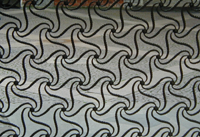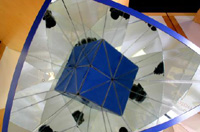The 17 wallpaper groups are an example of a (mathematical) situation where there exists a whole range of different notations (we may arrive even to 6 or 7 different notations!).
 In this website, we have been using two different notations: initially the cristallographic one (p6, p6m, p4, p4m, p4g, …) and later, while keeping this one for people who are acquainted with it, we also began to use the Conway notation (632, *632, 442, *442, 4*2;…), which is the one we are going to explain here.
In this website, we have been using two different notations: initially the cristallographic one (p6, p6m, p4, p4m, p4g, …) and later, while keeping this one for people who are acquainted with it, we also began to use the Conway notation (632, *632, 442, *442, 4*2;…), which is the one we are going to explain here.
 It would be nice if this notation (which has been introduced relatively recently by Thurston and Conway) could replace all the other ones in the next future!
It would be nice if this notation (which has been introduced relatively recently by Thurston and Conway) could replace all the other ones in the next future!
This may happen, as in fact it is not just a notation which gives different names to the same objects, but it is rather a different point of view, which brings many advantages since it unifies situations which seem very different, thus managing to use the same kind of notation for wallpaper groups, but also for friezes and for finite groups of space isometries (that is, for example, symmetry groups of polyhedra).
 The point of view we are referring to is the one of quotients which we can relate to Thurston’s “commandment” that is: “thou shalt know no geometrical group save by understanding its orbifold&&”.. You can find this commandment in the beautiful book by Conway The symmetries of things, in the introduction to the second part; the same book has been defined as “a testament to the power of good notation”.
The point of view we are referring to is the one of quotients which we can relate to Thurston’s “commandment” that is: “thou shalt know no geometrical group save by understanding its orbifold&&”.. You can find this commandment in the beautiful book by Conway The symmetries of things, in the introduction to the second part; the same book has been defined as “a testament to the power of good notation”.